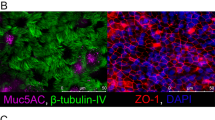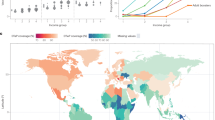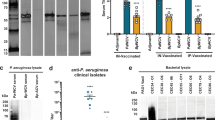Abstract
While single-dose mucosal immunization is best achieved by the use of attenuated live microorganisms, attenuation generally results in decreased immunogenicity. We attenuated Bordetella pertussis by the deletion of the pertussis toxin gene. A single intranasal administration of this strain protected against subsequent challenge as well as did the parent strain and better than immunization with commercial vaccine. Unexpectedly, this attenuation resulted in increased immunogenicity against the protective antigen filamentous hemagglutinin (FHA). In addition, immunogenicity was also enhanced against the Schistosoma mansoni Sm28GST genetically fused to FHA, resulting in protection against the parasite, as characterized by a reduction in worm burden and egg charge, after a single intranasal administration. Thus, attenuated recombinant B. pertussis strains are promising vectors for the simultaneous protection against pertussis and heterologous diseases by a single intranasal administration.
This is a preview of subscription content, access via your institution
Access options
Subscribe to this journal
Receive 12 print issues and online access
$259.00 per year
only $21.58 per issue
Buy this article
- Purchase on SpringerLink
- Instant access to full article PDF
Prices may be subject to local taxes which are calculated during checkout
Similar content being viewed by others
References
Hormaeche, C. and Khan, C.M.A. 1996. Recombinant bacteria as vaccine carriers of heterologous antigens, pp. 327–359 in Concepts in vaccine development. Kaufmann, S.H.E. (ed.). Walter de Gruyter, Berlin.
Wu, H.-Y. and Russell, M.W. 1997. Nasal lymphoid tissue, intranasal immunization, and compartmentalization of the common mucosal immune system. Immunol. Res. 16: 187–201.
Hirabayashi, Y., Kurata, H., Funato, H., Nagamine, T., Aizawa, C., and Kurata, T. 1990. Comparison of intranasal inoculation of influenza HA vaccine combined with cholera toxin B subunit with oral or parenteral vaccination. Vaccine 8: 243–248.
Robinson, K., Chamberlain, L.M., Schofield, K.M., Wells, J.M., and Le Page, R.W.F. 1997. Oral vaccination of mice against tetanus with recombinant Lactococcus lactis. Nature Biotechnology 15: 653–657
Bass, J.W. and Stephenson, S.R. 1987. The return of pertussis. Pediatr. Infect. Dis.J. 6: 141–144.
Jenkinson, D. 1988. Duration of effectiveness of pertussis vaccine: evidence from a 10 year community study. Br. Med. J. 296: 612–614.
Lambert, H.J. 1965. Epidemiology of a small pertussis outbreak in Kent County, Michigan. Public Health Rep. 80: 365.
Renauld-Mongénie, G., Mielcarek, N., Cornette, J., Schacht, A.-M., Capron, A., Riveau, G. and Locht, C. 1996. Induction of mucosal immune responses against a heterologous antigen fused to filamentous hemagglutinin after intranasal immunization with recombinant Bordetella pertussis. Proc. Natl Acad. Sci. USA 93: 7944–7949.
Mielcarek, N., Cornette, J., Schacht, A.-M., Pierce, R., Locht, C., Capron, A., and Riveau, G. 1997. Intranasal priming with recombinant Bordetella pertussis for the induction of a systemic immune response against a heterologous antigen. Infect. Immun. 65: 544–550.
Locht, C., Berlin, P., Menozzi, F.D. and Renauld, G. 1993. The filamentous hemagglutinin, a multifaceted adhesln produced by virulent Bordetella spp. Mol. Microbiol. 9: 653–660.
Black, W.J., Munoz, J.J., Peacock, M.G., Schad, P.A., Cowell, J.L., Burchall, J.J. et al. 1988. ADP-ribosyltransferase activity of pertussis toxin and immunomodu-lation by Bordetella pertussis. Science 240: 656–659.
Khelef, N., Bachelet, C.-M., Vargaftig, B.B., and Guiso, N. 1994. Characterization of murine lung inflammation after infection with parental Bordetella pertussis and mutants deficient in adhesins or toxins. Infect. Immun. 62: 2893–2900.
Antoine, R. and Locht, C. 1990. Roles of the disulfide bond and the carboxy-ter-minal region of the S1 subunit in the assembly and biosynthesis of pertussis toxin. Infect. Immun. 58: 1518–1526.
Ad hoc group for the study of pertussis vaccines.1988. Placebo-controlled trial of two acellular pertussis vaccines in Sweden—protective efficacy and adverse events. Lancet 331:955–960 (Published erratum appears in Lancet. 1988. 331: 1238).
Greco, D., Salmaso, S., Mastrantonio, P., Giuliano, M., Tozzi, A.E., Anemona, A. et al. 1996. A controlled trial of two acellular vaccines and one whole-cell vaccine against pertussis. N. Engl. J. Med. 334: 341–348.
Gustafsson, L., Hallander, H.O., Olin, P., Reizenstein, E. and Storsaeter, J. 1996. A controlled trial of a two-component acellular, a five-component acellular, and a whole-cell pertussis vaccine.N. Engl. J. Med. 334: 349–355.
Sato, Y., Kimura, M., and Fukumi, H. 1984.Development of a pertussis component in Japan. Lancet 324: 122–126.
Weiss, A.A., Hewlett, E.L., Myers, G.A. and Falkow, S. 1983. Tn5-induced mutations affecting virulence factors of Bordetella pertussis. Infect. Immun. 42: 33–41.
Locht, C. and Keith, J.M. 1986. Pertussis toxin gene: nucleotide sequence and genetic organization. Science 232: 1258–1264.
Warren, K.S. 1982. The secret of the immunopathogenesis of schistosomiasis: in vivo models. Immunol. Rev. 61: 189–213.
Capron, A., Dessaint, J.P., Capron, M., Ouma, J.H., and Butterworth, A.E. 1987. Immunity to schistosomes: Progress toward vaccine. Science 238: 1065–1072.
Shahin, R.D., Amsbaugh, D.F., and Leef, M.F. 1992. Mucosal immunization with filamentous hemagglutinin protects against Bordetella pertussis respiratory infection. Infect. Immun. 60: 1482–1488.
Greenberg, L. and Fleming, D.S. 1947. Increased efficiency of diphtheria toxoid when combined with pertussis vaccine. Can. J. Public Health 38: 279–282.
Lehrer, S.B., Vaughan, J.H., and Tan, E.M. 1975. Immunological and biochemical properties of the histamine-sensitizing factor of Bordetella pertussis. J. Immunol. 114: 34–39.
Vogel, F.R., Klein, T.W., Stewart II, W.E., Igarashi, T. and Friedman, H. 1985. Immune suppression and induction of gamma interferon by pertussis toxin. Infect. Immun. 49: 90–97.
Lobet, Y., Feron, C., Dequesne, G., Simoen, E., Hauser, P., and Locht, C. 1993. Site-specific alterations in the B oligomer that affect receptor-binding activities and mitogenicity of pertussis toxin. J. Exp. Med. 177: 79–87.
Menozzi, F.D., Mutombo, R., Renauld, G., Gantiez, C., Hannah, J.H., Leininger, E. et al. 1994. Heparin-inhibitable lectin activity of the filamentous hemagglutinin adhesin of Bordetella pertussis. Infect. Immun. 62: 769–778.
Sambrook, J., Fritsch, E.F., and Maniatis, T. 1989. Molecular cloning: a laboratory manual. Cold Spring Harbor Press, Cold Spring Harbor, NY.
Menozzi, F.D., Gantiez, C., and Locht, C. 1991. Interaction of the Bordetella pertussis filamentous haemagglutinin with heparin. FEMS Microbiol. Lett. 78: 59–64.
Hoiset, S.K. and Stocker, B.A.D. 1981. Aromatic-dependentSalmonella typhimurium are non virulent and effective as live vaccines. Nature 291: 238–239.
Author information
Authors and Affiliations
Rights and permissions
About this article
Cite this article
Mielcarek, N., Riveau, G., Remoué, F. et al. Homologous and heterologous protection after single intranasal administration of live attenuated recombinant Bordetella pertussis. Nat Biotechnol 16, 454–457 (1998). https://doi.org/10.1038/nbt0598-454
Received:
Accepted:
Issue date:
DOI: https://doi.org/10.1038/nbt0598-454
This article is cited by
-
The schistosome glutathione S-transferase P28GST, a unique helminth protein, prevents intestinal inflammation in experimental colitis through a Th2-type response with mucosal eosinophils
Mucosal Immunology (2016)
-
Immunity to the respiratory pathogen Bordetella pertussis
Mucosal Immunology (2012)
-
Clinical and Imaging Characteristics of Cerebral Schistosomiasis
Cell Biochemistry and Biophysics (2012)



